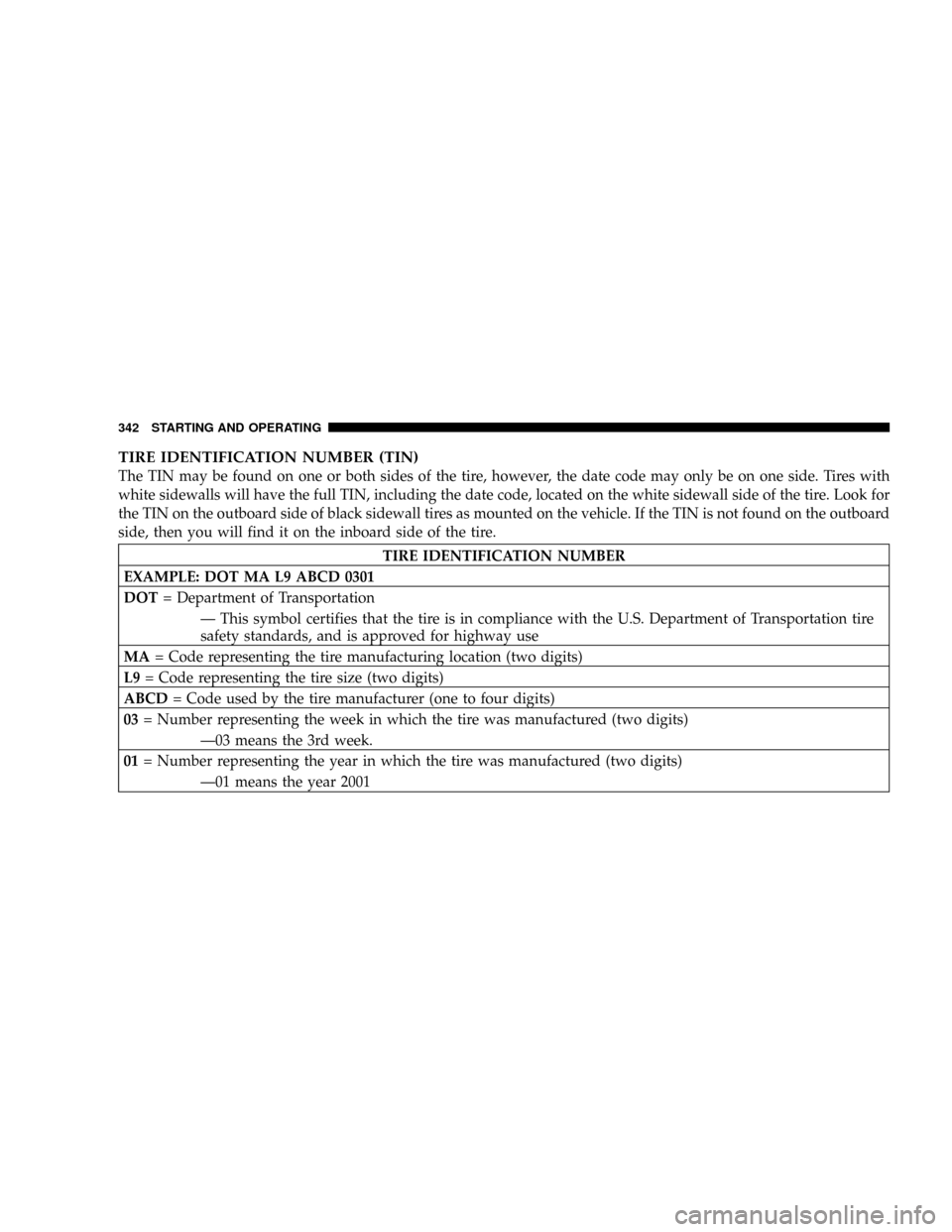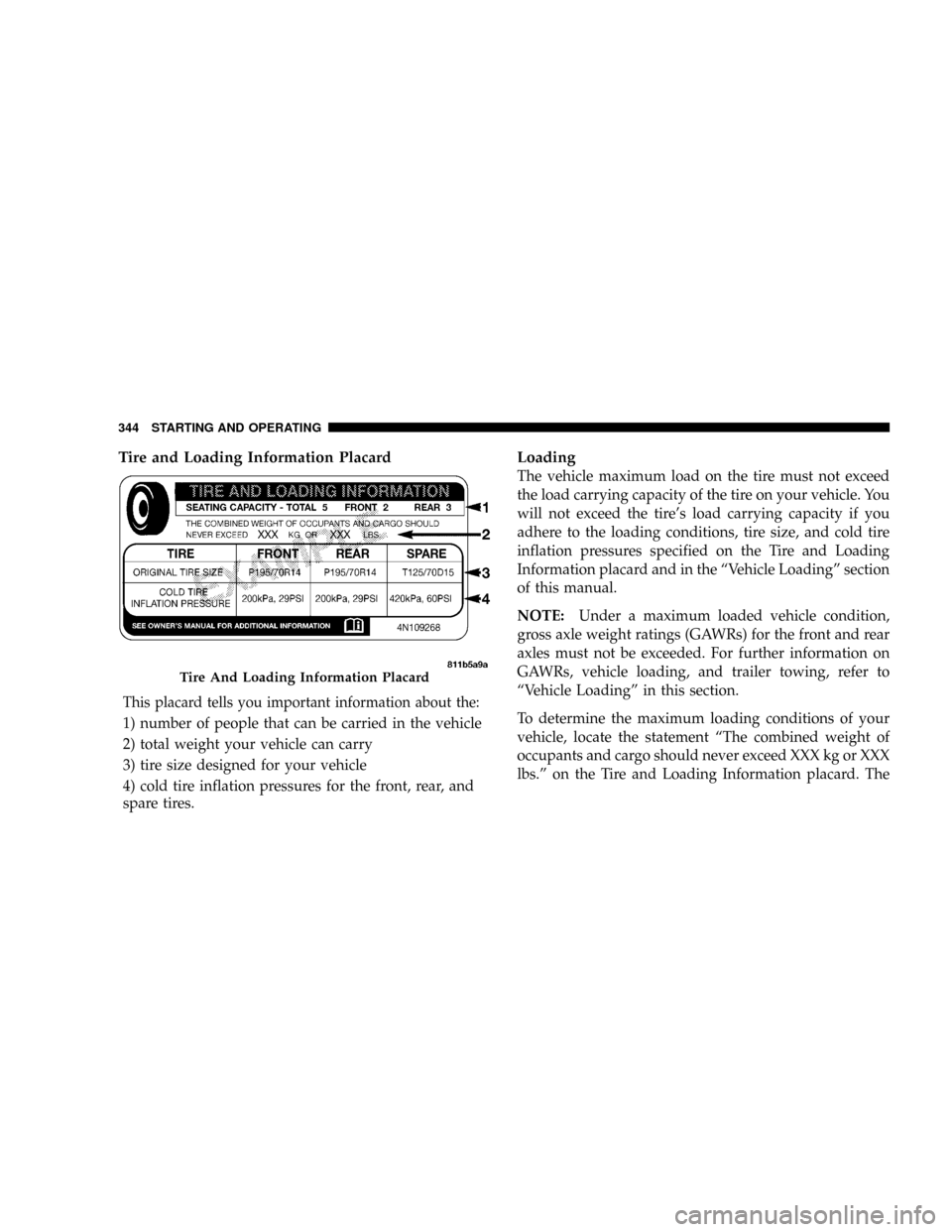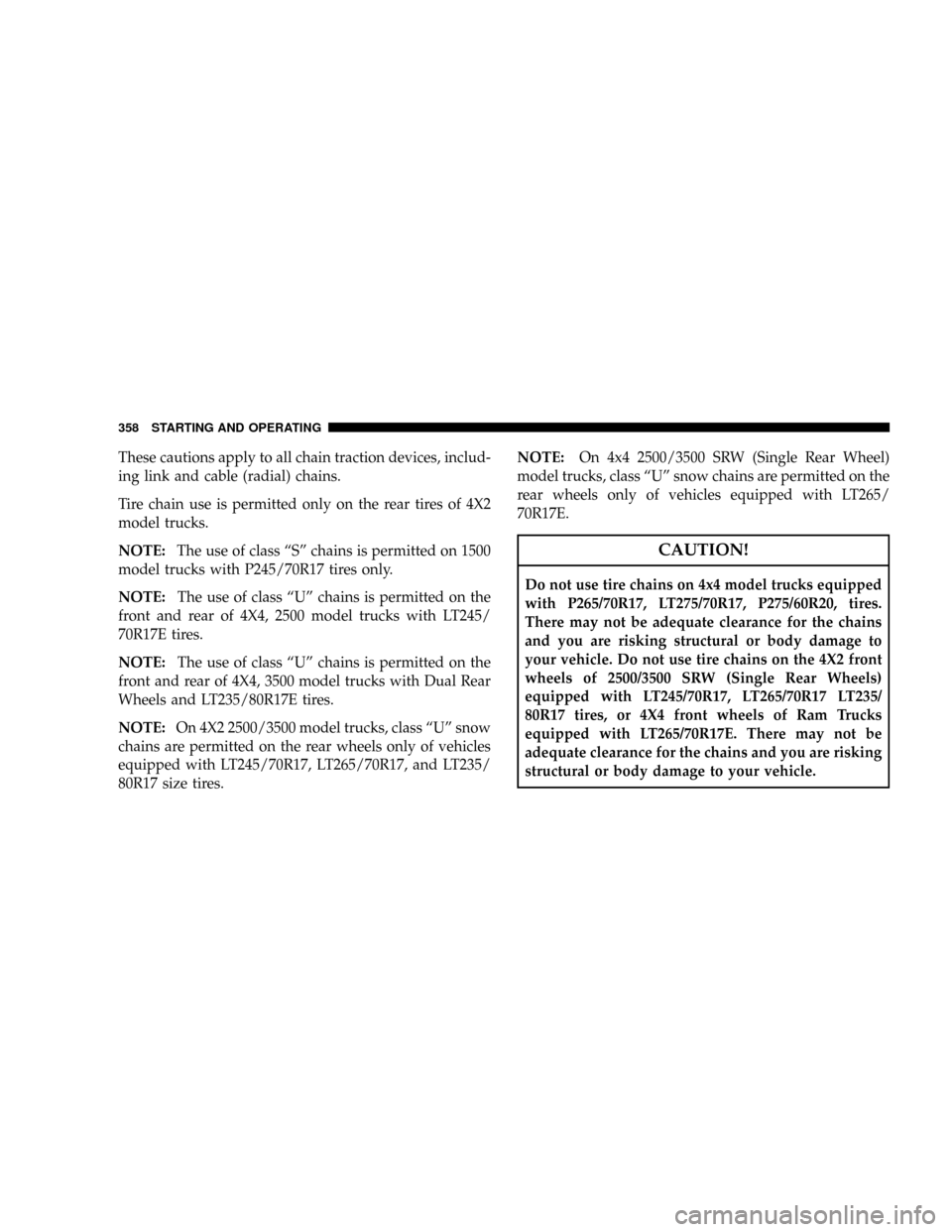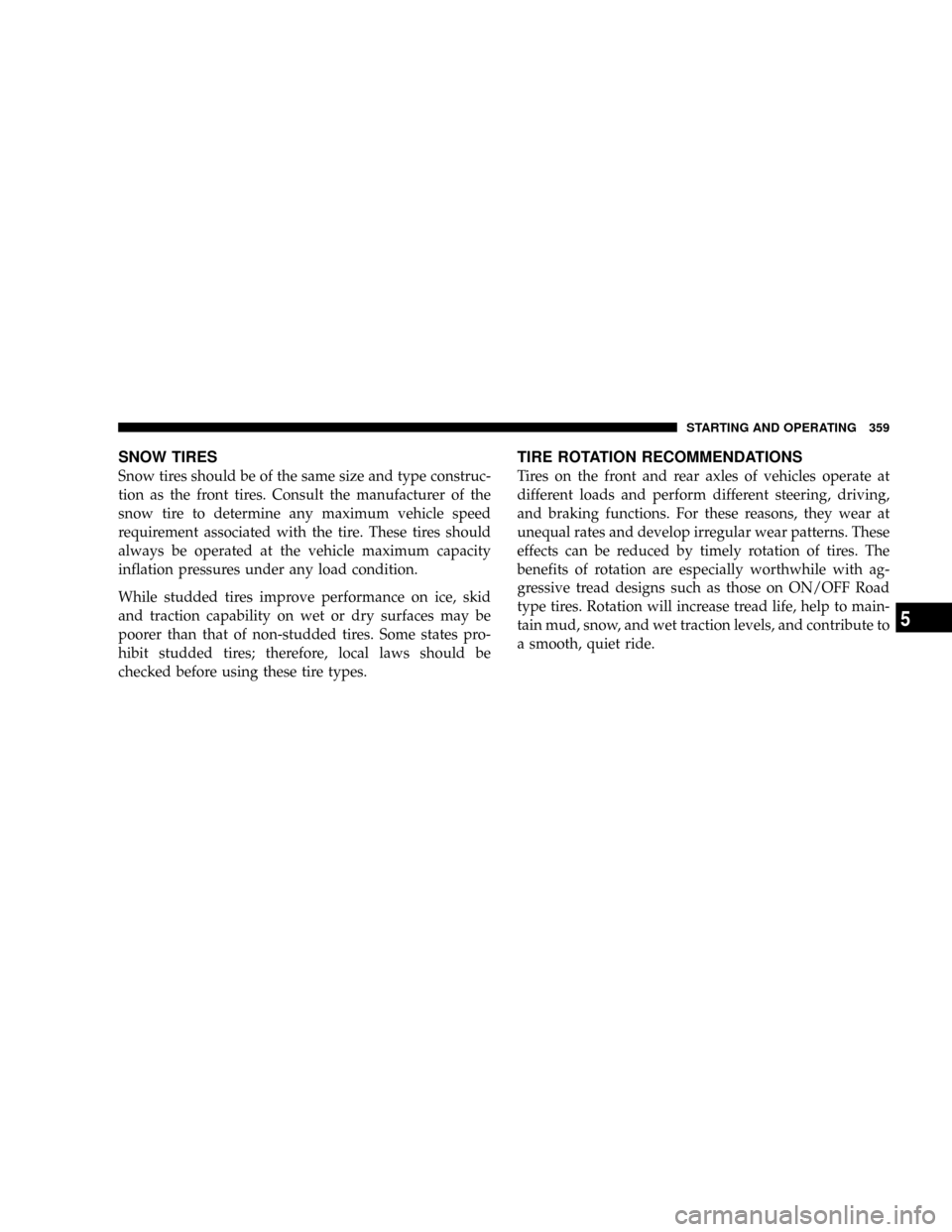Page 344 of 554

TIRE IDENTIFICATION NUMBER (TIN)
The TIN may be found on one or both sides of the tire, however, the date code may only be on one side. Tires with
white sidewalls will have the full TIN, including the date code, located on the white sidewall side of the tire. Look for
the TIN on the outboard side of black sidewall tires as mounted on the vehicle. If the TIN is not found on the outboard
side, then you will find it on the inboard side of the tire.
TIRE IDENTIFICATION NUMBER
EXAMPLE: DOT MA L9 ABCD 0301
DOT= Department of Transportation
Ð This symbol certifies that the tire is in compliance with the U.S. Department of Transportation tire
safety standards, and is approved for highway use
MA= Code representing the tire manufacturing location (two digits)
L9= Code representing the tire size (two digits)
ABCD= Code used by the tire manufacturer (one to four digits)
03= Number representing the week in which the tire was manufactured (two digits)
Ð03 means the 3rd week.
01= Number representing the year in which the tire was manufactured (two digits)
Ð01 means the year 2001
342 STARTING AND OPERATING
Page 346 of 554

Tire and Loading Information Placard
This placard tells you important information about the:
1) number of people that can be carried in the vehicle
2) total weight your vehicle can carry
3) tire size designed for your vehicle
4) cold tire inflation pressures for the front, rear, and
spare tires.
Loading
The vehicle maximum load on the tire must not exceed
the load carrying capacity of the tire on your vehicle. You
will not exceed the tire's load carrying capacity if you
adhere to the loading conditions, tire size, and cold tire
inflation pressures specified on the Tire and Loading
Information placard and in the ªVehicle Loadingº section
of this manual.
NOTE:Under a maximum loaded vehicle condition,
gross axle weight ratings (GAWRs) for the front and rear
axles must not be exceeded. For further information on
GAWRs, vehicle loading, and trailer towing, refer to
ªVehicle Loadingº in this section.
To determine the maximum loading conditions of your
vehicle, locate the statement ªThe combined weight of
occupants and cargo should never exceed XXX kg or XXX
lbs.º on the Tire and Loading Information placard. The
Tire And Loading Information Placard
344 STARTING AND OPERATING
Page 357 of 554

Replacement Tires
The tires on your new vehicle provide a balance of many
characteristics. They should be inspected regularly for
wear and correct cold tire inflation pressure. The manu-
facturer strongly recommends that you use tires equiva-
lent to the originals in size, quality and performance
when replacement is needed. (Refer to the paragraph on
ªTread Wear Indicatorsº). Refer to the ªTire and Loading
Informationº placard for the size designation of your tire.
The service description and load identification will be
found on the original equipment tire. Failure to use
equivalent replacement tires may adversely affect the
safety, handling, and ride of your vehicle. We recommend
that you contact your original equipment or an autho-
rized tire dealer with any questions you may have on tire
specifications or capability.WARNING!
DO NOT use a tire, wheel size or rating other than
that specified for your vehicle. Some combinations of
unapproved tires and wheels may change suspension
dimensions and performance characteristics, result-
ing in changes to steering, handling, and braking of
your vehicle. This can cause unpredictable handling
and stress to steering and suspension components.
You could lose control and have an accident resulting
in serious injury or death. Use only the tire and
wheel sizes with load ratings approved for your
vehicle.
STARTING AND OPERATING 355
5
Page 358 of 554

WARNING!
²NEVER use a tire with a smaller load index or
capacity, other than what was originally equipped
on your vehicle. Using a tire with a smaller load
index could result in tire overloading and failure.
You could lose control and have an accident.
²Failure to equip your vehicle with tires having
adequate speed capability can result in sudden tire
failure and loss of vehicle control.
CAUTION!
Replacing original tires with tires of a different size
may result in false speedometer and odometer
readings.
Alignment And Balance
Poor suspension alignment may result in:
²Fast tire wear.
²Uneven tire wear, such as feathering and one-sided
wear.
²Vehicle pull to right or left.
Tires may also cause the vehicle to pull to the left or right.
Alignment will not correct this condition. See your
authorized dealer for proper diagnosis.
Improper alignment will not cause vehicle vibration.
Vibration may be a result of tire and wheel out-of-
balance. Proper balancing will reduce vibration and
avoid tire cupping and spotty wear.
356 STARTING AND OPERATING
Page 359 of 554
![DODGE RAM 3500 GAS 2008 3.G Owners Manual SUPPLEMENTAL TIRE PRESSURE INFORMATION
Ð IF EQUIPPED
A light load vehicle condition is defined as two passen-
gers [150 lbs (68 kg) each] plus 200 lbs (91 kg) of cargo.
Cold tire inflation pressures DODGE RAM 3500 GAS 2008 3.G Owners Manual SUPPLEMENTAL TIRE PRESSURE INFORMATION
Ð IF EQUIPPED
A light load vehicle condition is defined as two passen-
gers [150 lbs (68 kg) each] plus 200 lbs (91 kg) of cargo.
Cold tire inflation pressures](/manual-img/12/5497/w960_5497-358.png)
SUPPLEMENTAL TIRE PRESSURE INFORMATION
Ð IF EQUIPPED
A light load vehicle condition is defined as two passen-
gers [150 lbs (68 kg) each] plus 200 lbs (91 kg) of cargo.
Cold tire inflation pressures for a lightly loaded vehicle
will be found on the face of the driver's door.
TIRE CHAINS
Use ªClass Sº chains on 1500 model Trucks, or other
traction aids that meet SAE Type ªSº specifications.
Use ªClass Uº chains on 2500/3500 model Trucks, or
other traction aids that meet SAE Type ªUº specifica-
tions.
NOTE:Chains must be the proper size for the vehicle,
as recommended by the chain manufacturer.
CAUTION!
To avoid damage to your vehicle, tires or chains, observe the
following precautions:
²Because of limited chain clearance between tires and other
suspension components, it is important that only chains in
good condition are used. Broken chains can cause serious
vehicle damage. Stop the vehicle immediately if noise occurs
that could suggest chain breakage. Remove the damaged parts
of the chain before further use.
²Install chains as tightly as possible and then retighten after
driving about 0.5 mile (0.8 km).
²Do not exceed 45 mph (72 km/h).
²Drive cautiously and avoid severe turns and large bumps,
especially with a loaded vehicle.
²Do not install tire chains on front wheels of 4x2 vehicles.
²Do not drive for a prolonged period on dry pavement.
²Observe the tire chain manufacturer's instructions on method
of installation, operating speed, and conditions for usage.
Always use the lower suggested operating speed of the chain
manufacturer if different than the speed recommended by the
manufacturer.
STARTING AND OPERATING 357
5
Page 360 of 554

These cautions apply to all chain traction devices, includ-
ing link and cable (radial) chains.
Tire chain use is permitted only on the rear tires of 4X2
model trucks.
NOTE:The use of class ªSº chains is permitted on 1500
model trucks with P245/70R17 tires only.
NOTE:The use of class ªUº chains is permitted on the
front and rear of 4X4, 2500 model trucks with LT245/
70R17E tires.
NOTE:The use of class ªUº chains is permitted on the
front and rear of 4X4, 3500 model trucks with Dual Rear
Wheels and LT235/80R17E tires.
NOTE:On 4X2 2500/3500 model trucks, class ªUº snow
chains are permitted on the rear wheels only of vehicles
equipped with LT245/70R17, LT265/70R17, and LT235/
80R17 size tires.NOTE:On 4x4 2500/3500 SRW (Single Rear Wheel)
model trucks, class ªUº snow chains are permitted on the
rear wheels only of vehicles equipped with LT265/
70R17E.
CAUTION!
Do not use tire chains on 4x4 model trucks equipped
with P265/70R17, LT275/70R17, P275/60R20, tires.
There may not be adequate clearance for the chains
and you are risking structural or body damage to
your vehicle. Do not use tire chains on the 4X2 front
wheels of 2500/3500 SRW (Single Rear Wheels)
equipped with LT245/70R17, LT265/70R17 LT235/
80R17 tires, or 4X4 front wheels of Ram Trucks
equipped with LT265/70R17E. There may not be
adequate clearance for the chains and you are risking
structural or body damage to your vehicle.
358 STARTING AND OPERATING
Page 361 of 554

SNOW TIRES
Snow tires should be of the same size and type construc-
tion as the front tires. Consult the manufacturer of the
snow tire to determine any maximum vehicle speed
requirement associated with the tire. These tires should
always be operated at the vehicle maximum capacity
inflation pressures under any load condition.
While studded tires improve performance on ice, skid
and traction capability on wet or dry surfaces may be
poorer than that of non-studded tires. Some states pro-
hibit studded tires; therefore, local laws should be
checked before using these tire types.
TIRE ROTATION RECOMMENDATIONS
Tires on the front and rear axles of vehicles operate at
different loads and perform different steering, driving,
and braking functions. For these reasons, they wear at
unequal rates and develop irregular wear patterns. These
effects can be reduced by timely rotation of tires. The
benefits of rotation are especially worthwhile with ag-
gressive tread designs such as those on ON/OFF Road
type tires. Rotation will increase tread life, help to main-
tain mud, snow, and wet traction levels, and contribute to
a smooth, quiet ride.
STARTING AND OPERATING 359
5
Page 365 of 554

The TPM System will continue to warn the driver of low
tire pressure as long as the condition exists, and will not
turn off until the tire pressure is at or above recom-
mended cold placard pressure. Once the low tire pressure
warning has been illuminated, the tire pressure must be
increased to the recommended cold placard pressure in
order for the TPMS warning lamp to be turned off. The
system will automatically update and the TPMS warning
lamp will extinguish once the updated tire pressures
have been received. The vehicle may need to be driven
for up to 10 minutes above 15 mph (25 km/h) to receive
this information.
As an example, assume your vehicle has a recommended
cold tire inflation placard pressure (parked for more than
3 hours) of 35 psi (241 kPa). If the ambient temperature is
68ÉF (20ÉC) and the measured tire pressure is 30 psi (207
kPa), a temperature drop to 20ÉF (-7ÉC) will decrease the
tire pressure to approximately 26 psi (179 kPa). This tire
pressure is sufficiently low enough to turn ON the TirePressure Monitoring lamp. Driving the vehicle may cause
the tire pressure to rise to approximately 30 psi (207 kPa),
but the Tire Pressure Monitoring lamp will still be ON. In
this situation, the Tire Pressure Monitoring lamp will
turn OFF only after the tires have been inflated to the
vehicle's recommended cold tire placard pressure value.
CAUTION!
The TPMS has been optimized for the original
equipment tires and wheels. TPMS pressures have
been established for the tire size equipped on your
vehicle. Undesirable system operation or sensor
damage may result when using replacement equip-
ment that is not of the same size, type, and/or style.
After-market wheels can cause sensor damage. Do
not use aftermarket tire sealants or balance beads if
your vehicle is equipped with a TPMS, as damage to
the sensors may result.
STARTING AND OPERATING 363
5